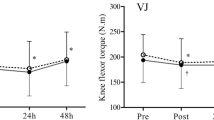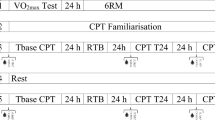Abstract
This study evaluated the effects of exercise-induced muscle damage (EIMD) on fixed-load cycling and 5-min time-trial performance. Seven recreational athletes performed two submaximal fixed-load exercise bouts followed by a 5-min time-trial before, 48 and 168 h following 100 counter-movement jumps. Measurements of \( \dot{V}{\text{O}}_{2} , \) heart rate, RER and blood lactate concentration remained unchanged during the fixed-load bouts following jumping exercise. However, \( \dot{V}_{\text{E}} \) and \( \dot{V}_{\text{E}} /\dot{V}{\text{O}}_{2} \) increased (P < 0.05) at 48 h. RPE values were higher at 48 h as were the ratio of RPE:HR and RPE:\( \dot{V}{\text{O}}_{2} \) (P < 0.05). In the time-trial, mean \( \dot{V}{\text{O}}_{2} , \) peak power output, mean power output, distance covered and post exercise blood lactate were lower at 48 h (P < 0.05). RPE remained unchanged between trials. These findings indicate that the ventilatory equivalent for oxygen and perceived exertion at submaximal work rates are increased 48 h following eccentric exercise. Furthermore, EIMD increases perceived exertion and impairs performance during a 5-min all-out effort.


Similar content being viewed by others
References
Ahmadi S, Sinclair PJ, Davis GM (2008) Muscle oxygenation after downhill walking induced muscle damage. Clin Physiol Funct Imaging 28:55–63
Ansley L, Schabort E, St Clair Gibson A, Lambert MI, Noakes TD (2004) Regulation of pacing strategies during successive 4-km time trials. Med Sci Sports Exerc 36:1819–1825. doi:10.1249/01.MSS.0000142409.70181.9D
Asp S, Daugaard JR, Kristiansen S, Kiensand B, Richter EA (1998) Exercise metabolism in human skeletal muscle exposed to prior eccentric exercise. J Physiol 509:305–313. doi:10.1111/j.1469-7793.1998.305bo.x
Bellinger AM, Reiken S, Dura M, Murphy PW, Deng SX, Landry DW et al (2008) Remodelling of ryanodine receptor complex causes “leaky” channels: a molecular mechanism for decreased exercise capacity. Proc Natl Acad Sci USA 105:2198–2202. doi:10.1073/pnas.0711074105
Braun WA, Dutto DJ (2003) The effects of a single bout of downhill running and ensuing delayed onset of muscle soreness on running economy performed 48 h later. Eur J Appl Physiol 90:29–34. doi:10.1007/s00421-003-0857-8
Brockett CL, Morgan DL, Gregory JE, Proske U (2002) Damage in different types of motor units following repeated active lengthening of the medial gastrocnemius muscle of the cat. J Appl Physiol 92:1104–1110
Byrne C, Eston R (2002) Maximal intensity isometric and dynamic exercise performance following eccentric muscle actions. J Sports Sci 20:951–959. doi:10.1080/026404102321011706
Byrne C, Eston RG, Edwards RHT (2001) Characteristics of isometric and dynamic strength loss following eccentric exercise-induced muscle damage. Scand J Med Sci Sports 11:134–140. doi:10.1046/j.1524-4725.2001.110302.x
Calbet JAL, Chavare J, Dorado D (2001) Running economy and delayed onset muscle soreness. J Sports Med Phys Fitness 41:18–26
Carson GC, Riek S, Shahbazpour N (2002) Central and peripheral mediation of human force sensation following eccentric or concentric contractions. J Physiol 539:913–925. doi:10.1113/jphysiol.2001.013385
Chen TC, Nosaka K, Tu J-H (2007) Changes in running economy following downhill running. J Sports Sci 25:55–63. doi:10.1080/02640410600718228
Cheung K, Hume PA, Maxwell L (2003) Delayed onset muscle soreness; treatment strategies and performance factors. Sports Med 33:145–164. doi:10.2165/00007256-200333020-00005
Davies RC, Eston RG, Poole DC, Rowlands AV, Dimenna F, Wilkerson DP et al (2008) The effect of eccentric exercise-induced muscle damage on the dynamics of muscle oxygenation and pulmonary oxygen uptake. J Appl Physiol 105(5):1413–1421. doi:10.1152/japplphysiol.90743.2008
Dutto DJ, Braun WA (2004) DOMS-associated changes in ankle and knee joint dynamics during running. Med Sci Sports Exerc 36:560–566. doi:10.1249/01.MSS.0000121957.83226.CC
Fridén J, Sjostrom M, Ekblom B (1983) Myofibrillar damage following intense eccentric exercise in man. Int J Sports Med 4:170–176
Gleeson M, Blannin AK, Zhu B, Brooks S, Cave R (1995) Cardiorespiratory, hormonal and haematological responses to submaximal cycling performed 2 days after eccentric or concentric exercise bouts. J Sports Sci 13:471–479. doi:10.1080/02640419508732264
Gleeson M, Blannin AK, Walsh NP, Field CN, Pritchard JC (1998) Effect of exercise-induced muscle damage on the blood lactate response to incremental exercise in humans. Eur J Appl Physiol Occup Physiol 77:292–295. doi:10.1007/s004210050336
Haouzi P, Hill JM, Lewis BK, Kaufman MP (1999) Responses of group III and IV muscle afferents to distension of the peripheral vascular bed. J Appl Physiol 87:545–553
Haouzi P, Chenuel B, Huszczuk A (2004) Sensing vascular distension in skeletal muscle by slow conducting afferent fibers: neurophysiological basis and implication for respiratory control. J Appl Physiol 96:407–418. doi:10.1152/japplphysiol.00597.2003
Hotta N, Sato K, Sun Z, Katayama K, Akima H, Kondo T et al (2006) Ventilatory and circulatory responses at the onset of exercise after eccentric exercise. Eur J Appl Physiol Occup Physiol 97:598–606. doi:10.1007/s00421-006-0212-y
Jameson C, Ring C (2000) Contributions of local and central sensations to the perception of exertion during cycling: effects of work rate and cadence. J Sports Sci 18:291–298. doi:10.1080/026404100365027
Jeukendrup AE, Saris WH, Brouns F, Kester AD (1996) A new validated endurance performance test. Med Sci Sports Exerc 28:266–270. doi:10.1097/00005768-199602000-00017
Kyröläinen H, Pullinen T, Candau R, Avela J, Huttnen P, Komi PV (2000) Effects of marathon running on running economy and kinematics. Eur J Appl Physiol 82:297–304. doi:10.1007/s004210000219
Laursen PB, Jenkins DG (2002) The scientific basis for high-intensity interval training: optimising training programmes and maximising performance in highly trained endurance athletes. Sports Med 32:53–73. doi:10.2165/00007256-200232010-00003
Laursen PB, Shing CM, Peake JM, Coombes JS, Jenkins DG (2005) Influence of high-intensity interval training on adaptations in well-trained cyclists. J Strength Cond Res 19:527–533. doi:10.1519/15964.1
Marcora SM, Bosio A (2007) Effect of exercise-induced muscle damage on endurance running performance. Scand J Med Sci Sports 17(6):662–671. doi:10.1111/j.1600-0838.2006.00627.x
Marginson V, Rowlands AV, Gleeson NP, Eston RG (2005) Comparison of the symptoms of exercise-induced muscle damage after an initial and repeated bout of plyometric exercise in boys and men. J Appl Physiol 99:1174–1181. doi:10.1152/japplphysiol.01193.2004
Michaut A, Pousson M, Babault N (2002) Is eccentric exercise-induced torque decrease contraction type dependent? Med Sci Sports Exerc 34:1003–1008. doi:10.1097/00005768-200206000-00016
Miles MP, Li Y, Rinard JP, Clarkson PM, Williamson JW (1997) Eccentric exercise augments the cardiovascular response to static exercise. Med Sci Sports Exerc 29:457–466. doi:10.1097/00005768-199704000-00006
Paschalis V, Koutedakis Y, Baltzopoulos V, Mougious V, Jamurtas AZ, Theoharis V (2005) The effects of muscle damage on running economy in healthy males. Int J Sports Med 26:827–831. doi:10.1055/s-2005-837461
Proske U, Weerakkody NS, Percival P, Morgan DL, Gregory JE, Canny BJ (2003) Force-matching errors after eccentric exercise attributed to muscle soreness. Clin Exp Pharmacol Physiol 30:576–579. doi:10.1046/j.1440-1681.2003.03880.x
Sargeant AJ, Dolan P (1987) Human muscle function following prolonged eccentric exercise. Eur J Appl Physiol 56:704–711. doi:10.1007/BF00424814
Schabort EJ, Hawley JA, Hopkins WG, Mujika I, Noakes TD (1998) A new reliable laboratory test of endurance performance for road cyclists. Med Sci Sports Exerc 30:1744–1750. doi:10.1097/00005768-199812000-00014
Scott KE, Rozenek R, Russo AC, Crussemeyer JA, Lacourse MG (2003) Effects of delayed onset muscle soreness on selected physiological responses to submaximal running. J Strength Cond Res 17:652–658. doi:10.1519/1533-4287(2003)017<0652:EODOMS>2.0.CO;2
Twist C, Eston RG (2005) The effects of exercise-induced muscle damage on maximal intensity intermittent exercise performance. Eur J Appl Physiol 94:652–658. doi:10.1007/s00421-005-1357-9
Walsh B, Tonkonogi M, Malm C, Ekblom B, Sahlin K (2001) Effect of eccentric exercise on muscle oxidative metabolism in humans. Med Sci Sports Exerc 33:436–441. doi:10.1097/00005768-200103000-00016
Weerakkody NS, Percival P, Morgan DL, Gregory JE, Proske U (2003) Matching different levels of isometric torque in elbow flexors after eccentric exercise. Exp Brain Res 149:141–150
Westing SH, Creswell AG, Thorstensson A (1991) Muscle activation during maximal voluntary eccentric and concentric knee extension. Eur J Appl Physiol Occup Physiol 62:104–108. doi:10.1007/BF00626764
Author information
Authors and Affiliations
Corresponding author
Rights and permissions
About this article
Cite this article
Twist, C., Eston, R.G. The effect of exercise-induced muscle damage on perceived exertion and cycling endurance performance. Eur J Appl Physiol 105, 559–567 (2009). https://doi.org/10.1007/s00421-008-0935-z
Accepted:
Published:
Issue Date:
DOI: https://doi.org/10.1007/s00421-008-0935-z




